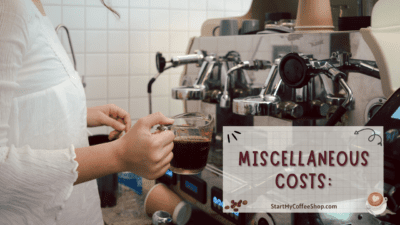One of the crucial aspects of starting a coffee shop is understanding the total cost involved. From equipment and rent to licenses, initial inventory, and staffing, several factors contribute to the overall expenses.
The total cost to open a coffee shop can vary widely depending on factors such as location, size, equipment, and furnishings. However, the general range is between $80,000 to $300,000.
In this comprehensive guide, we will delve into each component to provide aspiring coffee shop owners with valuable insights into estimating and managing the total cost of opening a coffee shop.
1. Location:
When choosing the location for your coffee shop, it’s crucial to understand the impact it has on the overall cost. The cost of rent is a major consideration, and it can vary greatly depending on factors such as the area, foot traffic, and local market conditions. In high-demand locations with heavy foot traffic, you may find yourself paying a higher price tag for the space. However, such locations also have the potential to attract a larger customer base, which can translate into increased sales and revenue.
When evaluating different locations, it’s important to consider various factors beyond just rent prices. Examine the lease terms to ensure they align with your long-term business goals and provide favorable conditions. Additionally, take note of the neighboring businesses and their target audience to determine if they complement or compete with your coffee shop. This can influence the potential for collaboration or increased competition.
Furthermore, consider the growth opportunities in the area. Are there upcoming developments or plans that could positively impact foot traffic and customer demand? Evaluating these growth prospects can help you make an informed decision about the location that aligns with your business vision and budget.
By carefully weighing all these factors, you can find a location that strikes the right balance between cost and potential customer base, setting the stage for a great coffee shop venture.
2. Equipment and Furnishings:
Investing in high-quality equipment and furnishings is a key factor in the progress of your coffee shop. These items encompass a range of essential components such as espresso machines, grinders, coffee makers, and refrigerators, as well as furniture and décor that create a welcoming atmosphere for customers.
To make informed decisions, it’s important to conduct thorough research on reputable suppliers and compare prices. Take into account not only the upfront cost but also the long-term value and reliability of the equipment. Consider your business goals and budget, and choose equipment that aligns with these factors.
Maintenance costs should also be factored into your decision-making process. Ensure that the equipment you select is not only of high quality but also comes with reliable customer support and accessible maintenance services. Additionally, check for warranty options to protect your investment and safeguard against potential repair expenses.
By investing in quality equipment and furnishings, you create a solid foundation for delivering exceptional coffee and providing a pleasant experience to your customers. A well-equipped coffee shop not only enhances the efficiency of your operations but also contributes to the overall ambiance and satisfaction of your patrons.
3. Licenses and Permits:
Obtaining the required licenses and permits is an essential step in the process of opening a coffee shop, as it ensures compliance with legal and health regulations. The cost of these licenses can vary based on your location and the specific permits needed for your coffee shop.
Common licenses include business permits, health permits, food handling certificates, and if you plan to serve alcoholic beverages, liquor licenses. Each of these licenses has its own set of requirements and associated fees. It is important to thoroughly research the local regulations and consult with the appropriate local authorities, such as the city or county clerk’s office or health department, to gain a clear understanding of the specific licenses and permits needed for your coffee shop.
By familiarizing yourself with the local requirements, you can accurately estimate the costs associated with obtaining the necessary licenses and permits. This will help you allocate the appropriate budget and ensure that you are fully compliant with the legal and health regulations governing your coffee shop.
4. Initial Inventory:

When opening a coffee shop, it is crucial to stock your inventory with high-quality coffee beans, syrups, milk, pastries, and other essential supplies. Estimating the quantities needed is vital and can be done by considering projected sales and customer demand.
To ensure a consistent supply of fresh ingredients, it is recommended to partner with reputable suppliers or local roasters. These suppliers can provide you with a reliable source of high-quality coffee beans and other necessary items. By establishing strong relationships with suppliers, you can secure favorable pricing and ensure that your inventory remains well-stocked.
It is important to keep in mind that inventory costs can fluctuate depending on the size of your coffee shop and the variety of products you offer. Larger coffee shops with extensive menus and higher customer demand may require larger quantities of inventory, resulting in higher costs. Conversely, smaller establishments with a more focused menu may have lower inventory costs.
Regularly monitoring inventory levels, tracking sales data, and adjusting your purchasing patterns accordingly can help optimize your inventory management and control costs. By striking a balance between maintaining sufficient stock and minimizing waste, you can efficiently manage your inventory and ensure a positive customer experience.
Remember, providing high-quality products through well-managed inventory is key to creating a favorable impression and building customer loyalty for your coffee shop.
Read more about Startup Cost Coffee Shop: The Art of Brewing and Budgeting
5. Staffing and Training:
The growth of your coffee shop hinges on the expertise and dedication of your staff members. It is crucial to carefully consider the number of employees required to efficiently handle the operations of your coffee shop. This typically includes baristas, cashiers, kitchen staff, and managers, depending on the size and scope of your establishment.
When budgeting for staffing, it is important to factor in wages, benefits, and any additional expenses associated with employment. Research the prevailing wages in your area to ensure that you are offering competitive compensation to attract and retain skilled individuals. Consider providing benefits such as healthcare, paid time off, and employee discounts to enhance job satisfaction and loyalty.
Investing in training and professional development is vital for your team’s achievement. Allocate resources for initial training to ensure that your staff members are equipped with the necessary skills and knowledge to deliver exceptional customer service and uphold the quality standards of your coffee shop. Additionally, budget for ongoing professional development opportunities, such as workshops or courses, to further enhance their skills and keep them engaged.
Maintaining a positive work environment is also essential. Foster a culture of teamwork, recognition, and open communication. Consider investing in employee incentives, team-building activities, and regular performance evaluations to motivate your staff and foster their growth.
Remember, your staff is the face of your coffee shop, and their dedication and expertise will greatly impact customer satisfaction and loyalty. By investing in their knowledge, skills, and job satisfaction, you create a strong foundation for a thriving coffee shop.
6. Marketing and Branding:
Consider various marketing channels and tactics to effectively reach your target audience. This may include social media campaigns to engage with potential customers, showcase your coffee offerings, and build an online community. Invest in website development to provide an informative and user-friendly online platform that reflects your brand identity and offers convenient features such as online ordering or a blog.
Local advertising can also play a significant role in increasing awareness and foot traffic. Explore options such as newspaper ads, radio spots, or targeted mailers to reach potential customers in your local community. Engaging with the community through partnerships or sponsorships with local events or organizations can further enhance your visibility and foster a positive brand image.
Consider hiring professionals or utilizing cost-effective digital marketing techniques to maximize your reach and impact. Digital marketing strategies like search engine optimization (SEO), email marketing, and influencer collaborations can help broaden your online presence and attract a wider audience.
Remember, consistency and authenticity in your branding and messaging are key. Develop a unique brand identity that resonates with your target market and communicates your coffee shop’s values and offerings effectively. By investing in marketing efforts, you can create a memorable brand image, attract customers, and build a loyal customer base for your coffee shop.
7. Miscellaneous Costs:

In addition to the major expenses previously discussed, it’s important to consider various miscellaneous costs when opening a coffee shop. These can include insurance coverage to protect your business and employees, as well as utilities such as electricity, water, and gas to ensure smooth daily operations. Investing in a reliable point-of-sale (POS) system and accounting software can help streamline transactions and financial management.
Don’t forget about signage to attract customers and create a recognizable brand presence. Packaging materials, such as cups, lids, sleeves, and bags, are also necessary for serving and offering takeaway options. Additionally, if any renovations or modifications are needed for your space to meet health or safety regulations or to align with your desired aesthetic, budget accordingly.
It’s wise to keep a buffer in your budget for unforeseen expenses and contingencies that may arise during the setup and early stages of your coffee shop. Unexpected repairs, equipment replacements, or marketing opportunities may require additional funds. By planning for contingencies, you can better manage these situations without jeopardizing your overall financial stability.
Read more about Startup Coffee Shop Costs: A Financial Breakdown
8. Financial Planning and Budgeting:
Creating a detailed financial plan and budget is essential for effectively managing the total cost of opening a coffee shop. Start by researching industry benchmarks and consulting with experts to gain insights into the typical expenses involved. Carefully estimate all costs, including equipment, rent, licenses, inventory, staffing, marketing, and miscellaneous expenses.
To gauge the financial viability of your coffee shop, determine the break-even point, which is the point at which your revenue covers all your expenses. This will give you an idea of the time required to start generating profits. Projected sales and revenue should be carefully calculated based on market research and realistic expectations.
It’s important to regularly review and track your financial performance to identify any areas that need adjustment. Analyze your income and expenses, monitor cash flow, and compare your actual performance against your projections. This will allow you to make informed decisions and take necessary actions to optimize your financial outcomes.
Summary
Opening a coffee shop can be a fulfilling entrepreneurial journey, but it requires a thorough understanding of the total cost involved. By carefully considering factors such as location, equipment, licenses, inventory, staffing, marketing, and miscellaneous costs, you can develop a comprehensive budget and financial plan.
Investing wisely and managing your expenses diligently will pave the way for a thriving coffee shop. Good luck with your caffeinated adventure!
Frequently Asked Questions

What are the major expenses involved in opening a coffee shop?
The major expenses include rent, equipment and furnishings, licenses and permits, initial inventory, staffing, and training, marketing and branding, as well as miscellaneous costs like insurance, utilities, and renovations.
How can I estimate the cost of rent for a coffee shop?
Estimating the cost of rent requires considering the location, square footage, local market conditions, and lease terms.
What are some tips for managing the total cost of opening a coffee shop?
To manage costs effectively, create a detailed financial plan, conduct thorough market research, compare prices from different suppliers, negotiate favorable lease terms, invest in staff training to reduce turnover, and regularly track and adjust your expenses based on your business’s performance.
To learn more on how to start your own coffee shop checkout my startup documents here
Please note: This blog post is for educational purposes only and does not constitute legal advice. Please consult a legal expert to address your specific needs.

Hi! I’m Shawn Chun
My adventure in coffee began when I first launched my first coffee shop back in the early 2000s. I had to figure out so many things on my own and to make it worse within 2 years of opening two large corporate coffee chains moved in just blocks away from me!
As I saw smaller and even some larger coffee shops in the neighborhood slowly lose customers to these giant coffee chains and slowly close up shop, I knew that I had to start getting creative…or go out of business.
I (like you may be) knew the coffee industry well. I could make the best latte art around and the foam on my caps was the fluffiest you have ever seen. I even had the best state-of-the-art 2 group digital Nuova Simonelli machine money could buy. But I knew that these things alone would not be enough to lure customers away from the name brand established coffee shops.
Eventually, through lots of trial and error as well as perseverance and creativity I did find a way to not only survive but also thrive in the coffee/espresso industry even while those corporate coffee chains stayed put. During those years I learned to adapt and always faced new challenges. It was not always easy, however, in the end, I was the sole survivor independent coffee shop within a 10-mile radius of my location. Just two corporate coffee chains and I were left after that year. All told the corporate coffee chains took down over 15 small independent coffee shops and kiosks and I was the last one standing and thriving.
Along the years I meet others with the same passion for coffee and I quickly learned that it is not only “how good a barista is” that makes a coffee shop successful, but the business side of coffee as well.
Hence why I started this website you are on now. To provide the tools and resources for up and coming coffee shop owners to gain that vital insight and knowledge on how to start a coffee shop successfully.
Stick around, browse through my helpful blog and resources and enjoy your stay! With lots of LATTE LOVE!
Shawn







